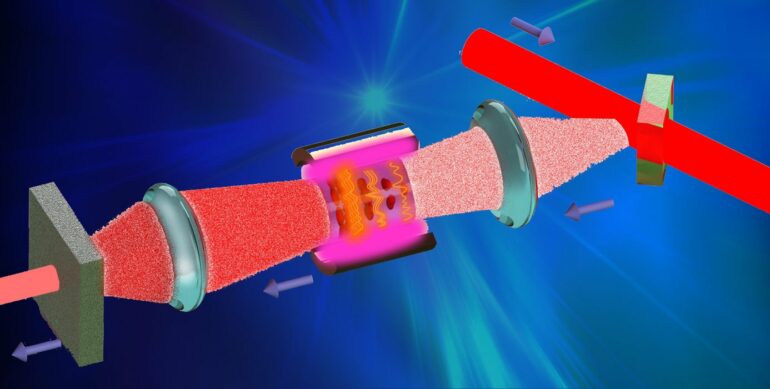Researchers in Caltech’s Andrew and Peggy Cherng Department of Medical Engineering have made a major step forward in medical imaging by taking inspiration from the field of astronomy.
The paper describing this research was published in Nature Photonics on January 23 and is titled “High-gain and high-speed wavefront shaping through scattering media.”
In astronomy, the light that reaches telescopes is distorted by the earth’s atmosphere, resulting in blurry images of planets, satellites, and other cosmic objects. The earth’s atmosphere is what’s known as a scattering medium; it scatters light, making images appear unfocused and cloudy. Wavefront shaping is a method of generating focused light by reversing the optical distortion caused by the atmosphere. In this method, a reflective device, like a mirror, “shapes” light waves to counterbalance distortion. It’s similar to a person wearing active noise-canceling headphones to combat ambient noise.
Biological tissue is also a scattering medium. The movement of blood, the motion of breathing, and the constant pumping of the heart creates fast-changing distortion, or cloudiness, when taking microscopic images of blood vessels, nerves, and even cancer cells. As an astronomer might use wavefront shaping to cancel out the distortion caused by the earth’s atmosphere, researchers in medical engineering have explored the use of wavefront shaping to cancel out distortion caused by biological tissue.
“When light goes through a scattered medium like a piece of tissue, it will simply scatter all over the place. That means we can’t directly focus light deep in tissue,” says Lihong Wang, Bren Professor of Medical Engineering and Electrical Engineering, and corresponding author of the paper. “Scattering has a cumulative effect. The more scattering photons go through, the more distortion we see. Through the use of wavefront shaping, we can mitigate the scattering effect and focus deeper into biological tissue.”
Wang’s lab employs a photo-refractive crystal to act as a “magic-mirror” that cancels out the distortion of light caused by tissue.
The process works like this: If you stare into a standard bathroom mirror, you’ll see a clear, undistorted image of yourself. Hold a glass bottle up to your eye between yourself and the mirror, and you’ll see a distorted, blurry image of yourself. This is because the bottle distorts the light waves on their way to the mirror and on their way back from the mirror into your eyes. The “magic” in the “magic mirror” is the ability to maintain the wave shape (called wavefront) by reversing the distortion it underwent. In other words, the returned light experiences the same distortion both on the way to the mirror and on the return trip back to you but reversed, causing the distortion to cancel itself out. When those wavefronts go through the bottle again, the result is a clear image of yourself as if the bottle wasn’t there.
However, using wavefront shaping to capture clearer images of biological tissue must satisfy three key metrics. Previous methods have not been able to satisfy all three.
The first key metric is speed. Since biological tissue is alive and moving, the entire wavefront shaping process must be done within a millisecond. “Only when you have the same object in the same state at the same location during the time reversal process can we cancel the wavefront distortion,” says Wang, who is also the Andrew and Peggy Cherng Medical Engineering Leadership Chair.
The second key metric is the so-called “control degrees of freedom.” Rather than a conventional mirror you might use to get dressed in the morning, the “magic mirror” used in wavefront shaping is composed of many small panels of mirrors. The more panels, the more control researchers have to tune and shape light waves to cancel out distortion.
The third key metric, and the one most challenging to Wang and the team, is the brightness or reflectivity of the mirror—the so-called “energy gain.” With the “magic mirror” used in high-speed wavefront shaping with high control degrees of freedom, reflectivity is often too dim to be effective. The research team found a solution in how a laser is produced.
When light waves are passed through a material with properties that allow it to amplify light—also called a gain medium—the electrons in the gain medium release energy in the form of additional light. This process amplifies the light waves, forming light that travels in a straight line—known as a laser. Similarly, a laser gain medium is used to amplify the scattered light waves getting to and reflecting off the magic mirror. “Metaphorically, this gain medium allows us to make the magic mirror shinier; it polishes the mirror, so to speak,” says Wang. The magic mirror itself remains the same while the light moving to and from the mirror becomes amplified and brighter.
In astronomy, wavefront shaping can turn a fuzzy blob into a clearer image of a distant planet. Translated to medical engineering, this new process of medical wavefront shaping has the potential to sharply focus on tissue to detect cancer below the skin.
“We report this technique that simultaneously achieves high-speed, high-energy gain—that means high reflectivity—and high control degrees of freedom. That means all three metrics have been satisfied for the first time,” says Wang. “This is a major step forward.”
More information:
Zhongtao Cheng et al, High-gain and high-speed wavefront shaping through scattering media, Nature Photonics (2023). DOI: 10.1038/s41566-022-01142-4
Provided by
California Institute of Technology
Citation:
Wavefront shaping: From telescopes to biological tissue (2023, February 27)



